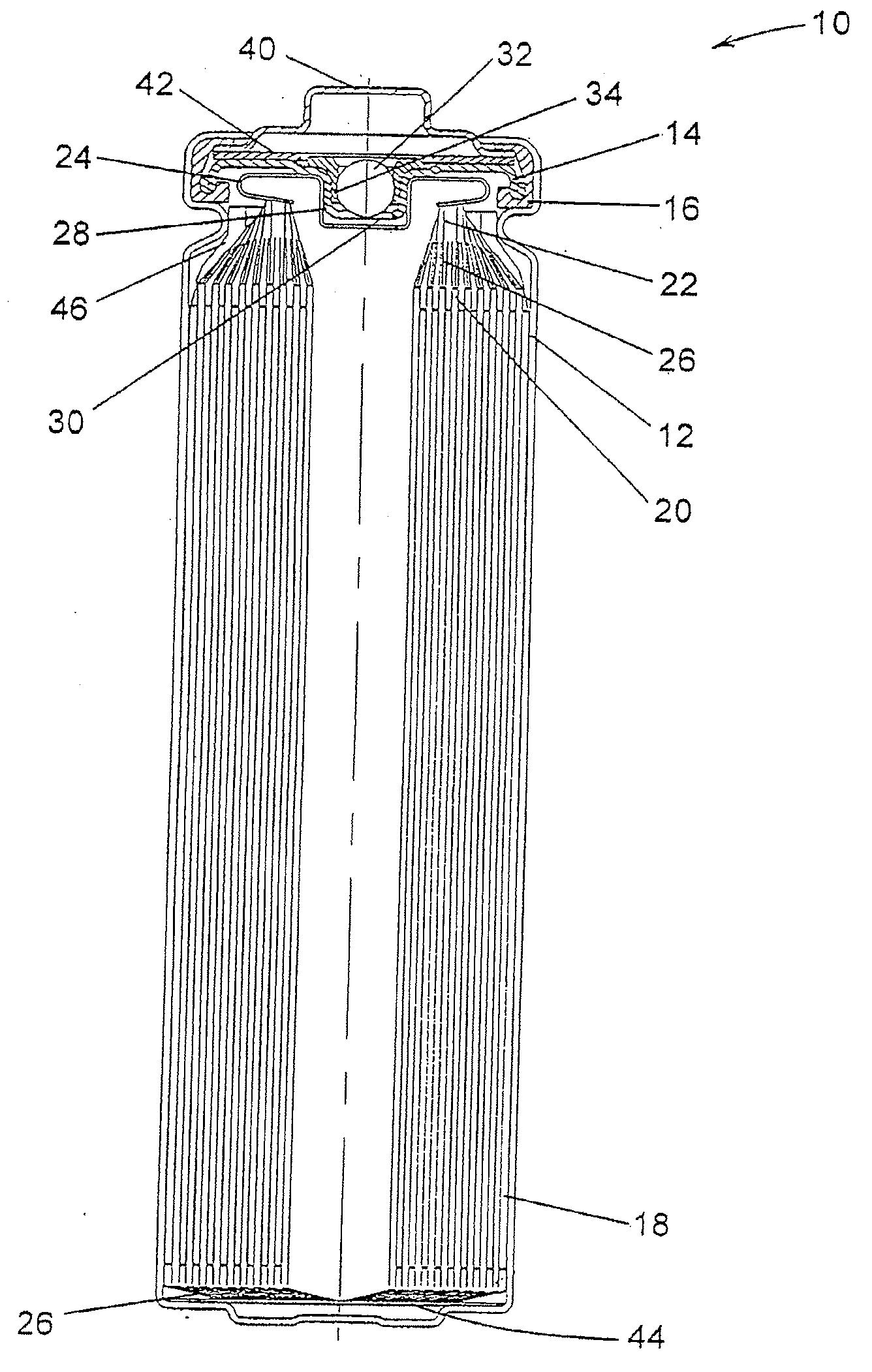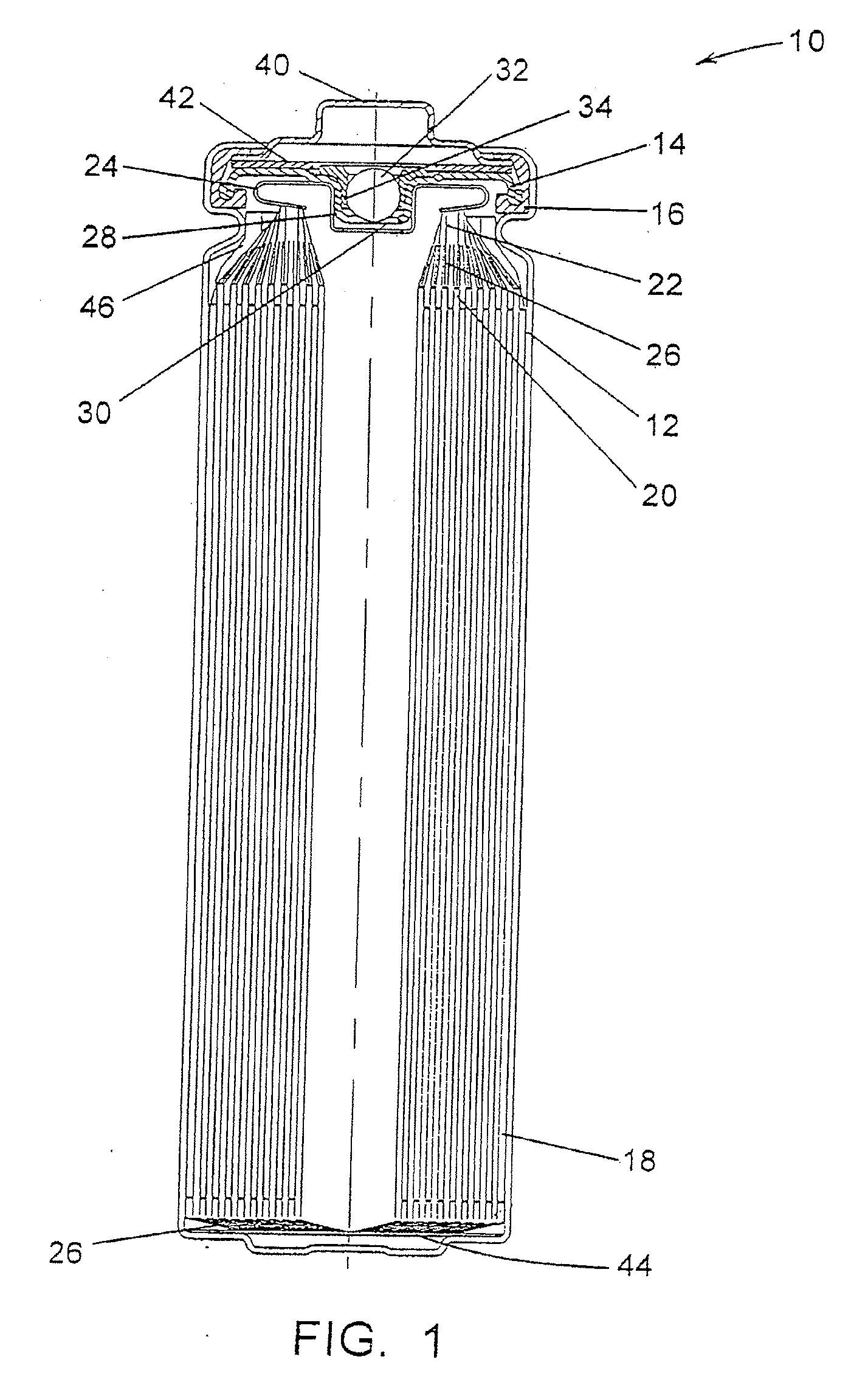High Discharge Capacity Lithium Battery
- Summary
- Abstract
- Description
- Claims
- Application Information
AI Technical Summary
Benefits of technology
Problems solved by technology
Method used
Image
Examples
example 1
[0105]FR6 type cylindrical Li / FeS2 cells with spirally wound electrode assemblies were made with varying electrode assembly void volumes per centimeter of interfacial electrode assembly height over a range of about 0.373 to about 0.455 cm3 / cm. The void volumes were varied by adjusting the volume of the voids within the active material mixture coated on the cathode. This was done with various combinations of mixture formulations, thickness and packing. The separator material used in all cells was a highly crystalline, unixially oriented, microporous polypropylene material with a 25 μm nominal thickness.
example 2
[0106]Samples of the cells from Example 1 were prepared for testing. For each group with a given void volume per unit of height, some cells remained undischarged and some cells were 50% discharged (discharged at a rate of 200 mA for the time required to remove 50 percent of the rated capacity). Undischarged and 50% discharged cells were tested on an Impact Test, and the external temperature of each of the cells tested was monitored during and for six hours after testing.
[0107]For the Impact Test a sample cell is placed on a flat surface, a 15.8 mm diameter bar is placed across the center of the sample, and a 9.1 kg mass is dropped from a height of 61±2.5 cm onto the sample. The sample cell is impacted with its longitudinal axis parallel to the flat surface and perpendicular to the longitudinal axis of the 15.8 mm diameter bar lying across the center of the cell. Each sample is subjected to only a single impact.
[0108]None of the undischarged cells had an external temperature that exc...
example 3
[0111]Four lots of FR6 cells were made, each with a separator made from a different material. A description of the separator materials is provided in Table 1, and typical separator properties, as determined by the methods described below, are summarized in Table 2. The separator material used for Lot A is the same as that used in the cells in Example 1. Each cell contained about 1.60 g of electrolyte, the electrolyte consisting of 9.14 weight percent Lil salt in a solvent blend of 1,3-dioxolane, 1,2-dimethoxyethane and 3,5-dimethylisoxazole (63.05:27.63:0.18 by weight).
TABLE 1Lot ALot BLot CLot Dhighly crystallinehighly crystallineamorphous biaxiallyamorphous biaxiallyuniaxially orienteduniaxially orientedoriented microporousoriented microporousmicroporousmicroporousultrahigh molecularpolyethylenepolypropylenepolypropyleneweight polyethylene20 μm thick25 μm thick20 μm thick20 μm thick
TABLE 2Property (units)Lot ALot BLot CLot DPorosity (%)38384240Max. effective pore size (μm)0.100.06...
PUM
 Login to View More
Login to View More Abstract
Description
Claims
Application Information
 Login to View More
Login to View More - R&D
- Intellectual Property
- Life Sciences
- Materials
- Tech Scout
- Unparalleled Data Quality
- Higher Quality Content
- 60% Fewer Hallucinations
Browse by: Latest US Patents, China's latest patents, Technical Efficacy Thesaurus, Application Domain, Technology Topic, Popular Technical Reports.
© 2025 PatSnap. All rights reserved.Legal|Privacy policy|Modern Slavery Act Transparency Statement|Sitemap|About US| Contact US: help@patsnap.com



